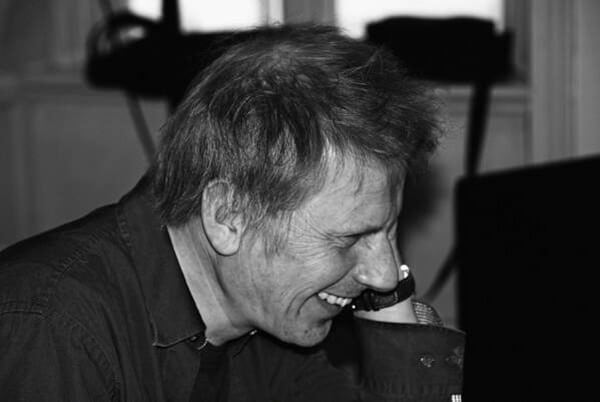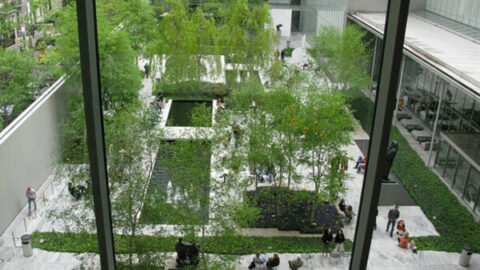 The Summergarden is a truly special place. It is the de facto backyard, if you will, of the Museum of Modern Art in New York City. It draws on elements of the city, such as concrete pathways and its own café, but it also draws on the serene, with its lush beech trees, a pond, a bridge, and ample greenery. Punctuating this layout are a variety of thought-provoking sculptures. Sparrows chirp from the trees, but you can still easily hear street traffic.
The Summergarden is a truly special place. It is the de facto backyard, if you will, of the Museum of Modern Art in New York City. It draws on elements of the city, such as concrete pathways and its own café, but it also draws on the serene, with its lush beech trees, a pond, a bridge, and ample greenery. Punctuating this layout are a variety of thought-provoking sculptures. Sparrows chirp from the trees, but you can still easily hear street traffic.
This is where several hundred people gathered to hear the New Juilliard Ensemble play on July 8. From my survey of the crowd, this diverse bunch was actually immersed in the concert. To the point, I can only count on the fingers of one hand the number of cell-phone checks while the music was playing—and that speaks volumes. All four pieces had their New York premiere, and all four used the complete chamber ensemble to its full capacity; these composers have an excellent command of texture, and it shows in their works. Joel Sachs led the New Juilliard Ensemble with his baton, and all performers were in fine form.

Sukhi Kang Myth opened with the piano and the vibes establishing a steady rhythm, which settled into a moderate 6/8 tempo. As the work attempted to portray a “mythical man”, the persistently searching scalar passages that never seemed to arrive in a key finally did settle into tonal areas, albeit for brief periods of time. The winds made liberal use of fluttertonguing but one was drawn back to humanity as the brassiness of the horn wavered and died away, and the winds interjected desperately by blowing air across their instruments.
Henrik Strindberg’s Timeline started with pizzicato contrabass as a foundation, as the strings, vibes, and piano began murmuring. The orchestration was very effective, as the acoustics of the space and open fifths produced a kaleidoscope of sound palettes in the opening. While the brevity of the melodic motifs and their frequently recycling was reminiscent of Glass, the treatment of time and tempo as plastic reminded me of John Adams’ Short Ride in a Fast Machine, as the tempo shifts were subtle and nearly seamless. As far as Strindberg took us with squeaky harmonics, broad atonal departures, and brief but significant lulls in energy, we were grounded nearly the whole time by strong bass declarations and the driving tempo.

Where Strindberg’s art lies primarily in the realm of the temporal, Hosokawa’s lies in the mastery of tension and texture. Every measure of Drawing reminded one of the composer’s alignment with Zen Buddhism. He opened with a solo violin note as the pianist plucked the lowest strings, creating an oceanic timbre. Throughout the piece the minor second was a major thematic device resolving to the unison, a simple but effective device for adding tension. What the piece lacked in melodic material it made up for in the brilliant use of various timbral and textural combinations, filling the mind with an other-worldly sense while still somehow remaining familiar. The tension increased as the violins played col legno tratto. A climax was reached with tremolos and trills blaring in all ranges, but the piece ended mysteriously, confusingly, in a quiet strung-out ending that didn’t seem to make sense musically.
Roberto Sierra’s Concierto de Camara stood apart from all the others in that it was divided into five movements, but also because of the more transparent (and danceable) rhythms and melodies. The first, third, and fifth were fast-paced dance movements, and the second and fourth were introspective, brooding interludes. This created an architecture of contrasts, which I believe was one of the factors that made this piece the most successful of the evening.

The first movement, “Overtura”, was a whimsical light dance which contained some beautiful counterpoint as well as some “grotesque” passages typical of Berlioz’s Symphonie Fantastique. The first interlude featured the solo bassoon in a pensive, tender melody against a lush background of strings. The central movement, “Juegos”, was a moto perpetuo with an intoxicating driving rhythm that was very refreshing after the previous, slower movement. The rhythm was kept fresh by alternating duple and triple tempi. Unpredictable dynamic contrasts also kept the listeners on their toes. The second interlude wandered further than the first, with the full winds against pizzicato strings, the cello keeping time with slow, steady pulsations. Fhe finale, “Danza”, was outright fun, with syncopated salsa rhythms and a few Mahler-esque sections.
The combination of the idyllic park in the middle of the concrete jungle, and the fresh music with delightful contrasts, made for a unique experience. Rarely have I seen a concert where nearly the entire audience leaves their busy lives, emails and texts at the door, and just takes in the music. MoMA’s Summergarden is genuinely refreshing, and I look forward to going back.
—
Neil Prufer is a composer and pianist living in New York City.
























